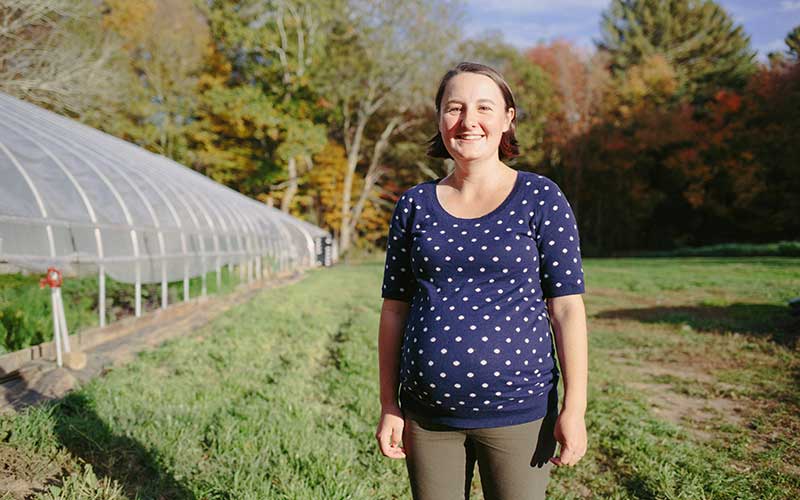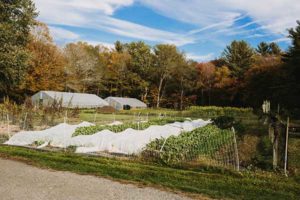
Allyson Angelini has owned Full Heart Farm with her husband for five years. Photo: Lori Paulsen
This blog is part of our occasional series on young farmers in Connecticut.
Before starting Full Heart Farm in Ledyard, Connecticut, Allyson Angelini knew exactly what she wanted: to live on her own farm that could provide a community-supported agriculture program to nearby residents. Yet like so many young Connecticut farmers, realizing this vision proved a difficult path.
Connecticut is drawing in more and more young farmers these days. According to the latest figures, about 5 percent of the state’s almost 6,000 farmers are under 35 – a 150-percent increase since 2007. And, of all new farmers in the state (those who have operated a farm for fewer than ten years), 16 percent are also young, including both full-time and part-time farmers.
All of this means a lot of beginning and young farmers are already operating in Connecticut, with more expected. Among them is Allyson Angelini.
A Young Farmer in the Making
Allyson grew up in Ledyard, but not in a farming family. In fact, she never planned to return to her hometown after college. But during a semester abroad in Tuscany, she found herself working on a 1,500-acre sustainable farm. Suddenly, as part of this faraway local food system, Allyson discovered a joy unlike any she had yet experienced.
“There was a satisfaction in getting up every day and working toward a goal,” she told me one crisp autumn afternoon, while we walked around her six-and-a-half-acre farm.
When she returned to the United States, Allyson continued her work in agriculture. She found a job at a dairy farm, and for a year, she split her time between there and classes. Each morning, she left her house at 4:00 AM to milk the cows before turning her attention to studying. After graduating, Allyson moved back to Connecticut and found a farm apprenticeship at a large family farm.
From Apprentice to Owner
Allyson soon became the farm’s manager and created a farm-to-table cooking school that still thrives there today. As luck would have it, it’s also where she met her future husband, Keith.
Yet she was driven by a growing desire to one day run her own farm. “I wasn’t quite in my spot yet,” she recalled.
Allyson understood that farm ownership comes with big risks: “If you’re not a hundred percent sure you want to own a farm – the risk of failure is ridiculously high – it’s a lot easier to test the water with a lease. You can’t walk away if you own it.”
But she felt ready for the challenge. At 24 years old and with three years of farm management experience, she began the work to make her vision a reality. Her first task: figuring out how to finance this dream. While farming, she had regularly stashed bits of extra income away. “I had saved $20,000, which was a lot of money to me,” she said. But it wasn’t enough for a down payment on Connecticut farmland. So she turned to the USDA Farm Service Agency (FSA) for help.
Allyson’s First Challenge: Financing Her Dream
“I started filling out the mountains of FSA loan paperwork – it was an incredible amount of paperwork. I’m pretty sure I was the first farmer in the state to go through that,” Allyson said, referring to the Agency’s direct farm-ownership loan application.
Although the FSA’s direct farm-ownership loans allow beginning farmers to access financing using non-traditional credit requirements and with very low-interest rates, those loans are capped at $300,000. Here in New England, where farmland prices are often prohibitive, that means very few beginning farmers get access to these loans. According to the USDA, the FSA did not issue a direct farm-ownership loan to beginning farmers in Connecticut during the past three fiscal years. Except during fiscal year 2017, Connecticut was the only state not to receive such a loan.
That makes Allyson a rarity in the state. But applying for and receiving her FSA loan was only her first struggle.
Her Next Challenge: A Shortage of Affordable Farmland
With her financing approved, Allyson embarked on her next task: searching for farmland, which would prove as daunting as those pages and pages of loan applications. As she soon discovered, Connecticut has some of the most expensive farmland in the United States, behind only New Jersey and Rhode Island, according to the latest USDA statistics. Moreover, Connecticut farms have been shrinking, losing an average of ten acres per farm between 2007 and 2012.
Efforts to preserve Connecticut farmland provide some relief. The Connecticut Department of Agriculture administers the Farmland Preservation Program, which establishes conservation easements on select farmland to ensure that land remains in agriculture in perpetuity. Farmland trusts, such as the Connecticut Farmland Trust, also work to keep farmland active. Similarly, organizations, such as Land For Good, help connect farmers with available land.
But this relief is not complete. As CLF and others have previously found, gaps in estate planning, children leaving farms, prohibitive real estate costs, and pressure from development are just a few reasons land leaves agriculture, farms get smaller, and new farmers have a tough time finding suitable farmland.
“Perhaps nowhere else in the country are farms and farmers more endangered,” the American Farmland Trust has warned of New England.
Finding Her Farm
Even with her loan in hand, as a young farmer just starting out, Allyson knew her options for farmland would be limited. For months, she looked at the handful of available properties she could afford. But for one reason or another, none of them could accommodate her needs. “I knew I wanted to live on a farm – a piece of property with a house, plumbing, and electricity – and a place I could legally farm under the town’s zoning code,” she recalled.
Then, just a couple of miles away from her childhood home, she found a farm and home in desperate need of repair. With an eye toward real estate investment, Allyson felt confident that she could turn the place around. It was not her dream farm, but it had everything she needed to establish her business and raise her family.
Allyson remembers the exact day she found her new farm: April 30, 2012. After signing the closing papers at the real estate office, she pulled up that afternoon to her dilapidated barn. Her pigs and chickens sat in the back of her pickup truck, and she had 150 chicks arriving in the next couple of days. She was ready to start farming.

Turning Vision into Reality
Five years on, Allyson, now 29, and Full Heart Farm are succeeding. Using holistic management techniques, Allyson grows 120 varieties of vegetables and raises pigs and chickens. Like many other young Connecticut farmers, she continuously innovates new ways to reach her customers.
“The local food movement is changing,” she said as we sat in the barn. “Young farmers are driving it. They’re creating new markets and driving specialty crop production, niche marketing. This isn’t what the ag scene looked like 15 years ago.”
Despite recently losing crops to unpredictable weather, worrying about being able to pay her mortgage and farm loan, wondering how her two (soon to be three) children are going to adapt to farm life – despite all that has and still could go wrong – Allyson has long known that owning her own farm was the best decision she could have made.
“We have a beautiful life and make beautiful food and grow beautiful things,” she rejoiced. “It’s hard not to want that.”
Young farmers in New England face all sorts of challenges. CLF’s Legal Food Hub has helped many of them realize their own visions of farm ownership – from formalizing their lease agreements to hiring their first employee – by connecting them with pro bono legal services. Connecticut is now the fourth New England state to host this valuable program.



